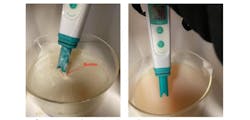Reduced Metalworking Fluid Management Costs
BOLB INC., a provider of UV LED technology, will release its SUVOS BioCleanse UVC module at IMTS 2024 – in booth 236376 – a cost-effective and environmentally friendly solution that extends the useful lifetime of metalworking fluids (MWF) and improves worker health and safety.
“Savings thousands of dollars per machine are already being realized from our early installations,” stated Bolb CRO Frank Harder. “Our UV-C LED solution improves the quality of the cutting and cooling oil without the use of harmful chemicals and significantly reduces maintenance downtime, labor, and disposal costs. Even in smaller shops, the benefits and savings can be substantial.”
Metalworking fluids can have relatively short lifetimes and require regular maintenance and management to effectively remove biological contaminants. Maintenance programs require downtime for fluid replacement and cleaning. Biological contaminants pose risks to worker health and safety, including secondary dermatitis, sepsis, and chronic diseases from long-term exposure to bacteria, mold spores, and toxic biocides.
The SUVOS BioCleanse UVC module deactivates or kills biological contaminants, reduces or eliminates odors due to chemical decomposition or reactions, and significantly extends MWF lifespan, thus reducing maintenance costs.
According to Tony Gallien, founder and CEO of T&K Machine, “Bolb’s solid-state SUVOS BioCleanse solution has revolutionized the way I maintain my CNC machines. Not only does it save me valuable time by eliminating the need for constant maintenance, but it also enhances the quality of the cutting and cooling oil. Since implementing, I’ve seen a significant increase in productivity and significant savings of about $2,000 per machine per year.”
Using SUVOS in a centralized treatment system capable of handling 135 tons of MWF at a 6-ton/min flow rate or higher can lengthen the life of glass-cutting coolant from 3 weeks to 6 months.
As MWF flow across UVC light emitted from SUVOS BioCleanse, the light quickly and efficiently breaks the chemical bonds in the DNA and RNA of biological contaminants and stops their growth. As a result, the MWF stays “clean” longer; odors and biological hazards are virtually eliminated; and pH levels stay higher over time, so the MWF retain their anti-corrosion properties.
Learn more at www.bolb.co

